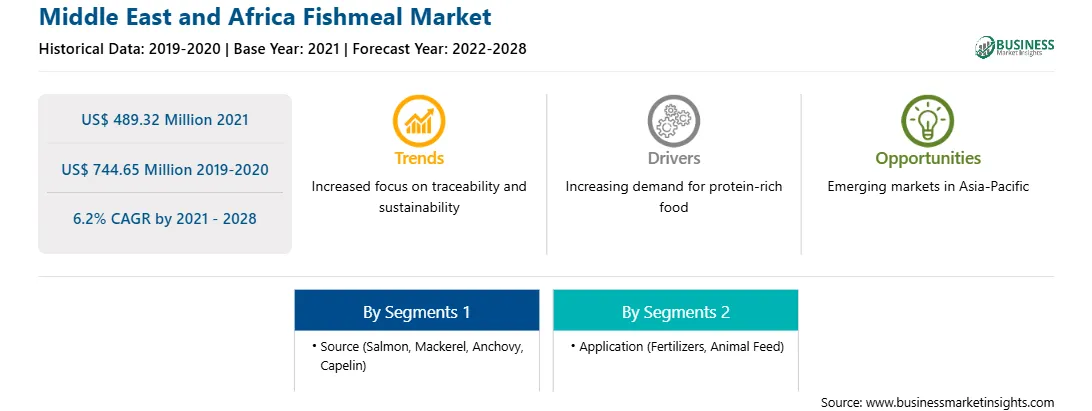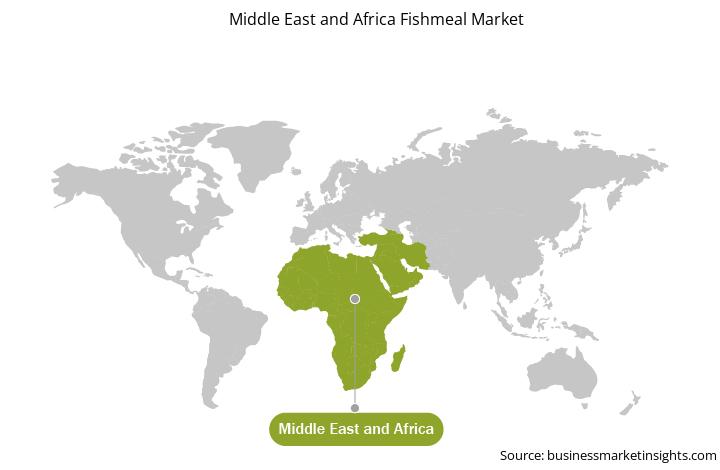Market Introduction
The Middle East primarily depends on imported goods and products, including food and beverages. The lack of suitable weather conditions for agricultural production has led the Middle East to turn to aquaculture projects as viable sources for improving food security in the region. Currently, numerous new aquaculture projects are operating in Saudi Arabia, the UAE, and Oman, driving the demand for fishmeal. Africa consists of 48 countries and five island nations, most of which are practicing aquaculture. Zambia, Madagascar, and Nigeria are among the largest producers of aquaculture. The high demand for fish and the availability of inexpensive labor have led to a rise in aquaculture in the region. Moreover, it is considered as a major contributor to food security in the future. Developing countries in the MEA are contributing to the high seafood product demand. Continuously increasing demand for high-protein diet, especially among fitness-savvy consumers, is expected to propel the fishmeal market further in the region during the forecast period.
Due to the lockdowns in the MEA countries, numerous fishmeal food companies remain closed, and production activities have discontinued; thus, these factors can negatively impact the region's fishmeal and the fishmeal industry.
Strategic insights for the Middle East and Africa Fishmeal provides data-driven analysis of the industry landscape, including current trends, key players, and regional nuances. These insights offer actionable recommendations, enabling readers to differentiate themselves from competitors by identifying untapped segments or developing unique value propositions. Leveraging data analytics, these insights help industry players anticipate the market shifts, whether investors, manufacturers, or other stakeholders. A future-oriented perspective is essential, helping stakeholders anticipate market shifts and position themselves for long-term success in this dynamic region. Ultimately, effective strategic insights empower readers to make informed decisions that drive profitability and achieve their business objectives within the market. The geographic scope of the Middle East and Africa Fishmeal refers to the specific areas in which a business operates and competes. Understanding local distinctions, such as diverse consumer preferences (e.g., demand for specific plug types or battery backup durations), varying economic conditions, and regulatory environments, is crucial for tailoring strategies to specific markets. Businesses can expand their reach by identifying underserved areas or adapting their offerings to meet local demands. A clear market focus allows for more effective resource allocation, targeted marketing campaigns, and better positioning against local competitors, ultimately driving growth in those targeted areas.Middle East and Africa Fishmeal Strategic Insights

Middle East and Africa Fishmeal Report Scope
Report Attribute
Details
Market size in 2021
US$ 489.32 Million
Market Size by 2028
US$ 744.65 Million
Global CAGR (2021 - 2028)
6.2%
Historical Data
2019-2020
Forecast period
2022-2028
Segments Covered
By Source
By Application
Regions and Countries Covered
Middle East and Africa
Market leaders and key company profiles
Middle East and Africa Fishmeal Regional Insights

Market Overview and Dynamics
The fishmeal market in MEA is expected to grow from US$ 489.32 million in 2021 to US$ 744.65 million by 2028; it is estimated to grow at a CAGR of 6.2% from 2021 to 2028. The industrialization of animal farming has increased the demand for protein-rich animal feed ingredients to raise the feed conversion rate. Industrially raised livestock are mainly fed on concentrates made from cereal and vegetable protein such as soybean meals to assist them in gaining weight and producing protein-rich meat. Farm animals depend on proteins and other elements as building blocks essential for growth. Proteins in animal feeds are an excellent energy source and essential amino acids, such as lysine and methionine. The growing awareness about the health benefits of proteins on animal health has created a substantial demand for various protein feeds, such as animal protein meals, feather meals, fishmeal, bone meal, and blood meal. Fishmeal is a rich source of protein, minerals, and fatty acids and is easily digested by the livestock upon consumption. High-quality fishmeal enables the formulation of nutrient-dense livestock diets, promoting their optimal growth. As livestock and farm animals contribute significantly to the food supply chain, the demand for protein-rich nutritious animal feed is rising and is expected to continue during the forecast period. The constantly burgeoning demand for protein-rich animal feeds to promote growth in livestock at all stages of life is driving the overall fishmeal market substantially.
Key Market Segments
The MEA fishmeal market is segmented into source, application, and country. Based on source, the MEA fishmeal market is segmented into salmon, mackerel, anchovy, capelin, and others. In 2020, the anchovy segment accounted for the largest revenue share. Based on application, the MEA fishmeal market is segmented into animal feed, agriculture, and others. In 2020, the animal feed segment accounted for the largest revenue share. Based on country, the MEA fishmeal market is segmented into Saudi Arabia, South Africa, UAE, and rest of the MEA. Rest of the MEA held the largest market share in 2020.
Major Sources and Companies Listed
A few major primary and secondary sources referred to for preparing this report on the fishmeal market in MEA are company websites, annual reports, financial reports, national government documents, and statistical databases, among others. Major companies listed in the report are COPEINCA; Oceana Group Limited; Pelagia AS; Soytex LTD; TASA; and The Scoular Company.
Reasons to buy report
MEA
Fishmeal Market
Segmentation
MEA Fishmeal Market -
By Source
MEA Fishmeal Market - By
Application
MEA Fishmeal Market - By Country
MEA Fishmeal Market - Company Profiles
The Middle East and Africa Fishmeal Market is valued at US$ 489.32 Million in 2021, it is projected to reach US$ 744.65 Million by 2028.
As per our report Middle East and Africa Fishmeal Market, the market size is valued at US$ 489.32 Million in 2021, projecting it to reach US$ 744.65 Million by 2028. This translates to a CAGR of approximately 6.2% during the forecast period.
The Middle East and Africa Fishmeal Market report typically cover these key segments-
The historic period, base year, and forecast period can vary slightly depending on the specific market research report. However, for the Middle East and Africa Fishmeal Market report:
The Middle East and Africa Fishmeal Market is populated by several key players, each contributing to its growth and innovation. Some of the major players include:
The Middle East and Africa Fishmeal Market report is valuable for diverse stakeholders, including:
Essentially, anyone involved in or considering involvement in the Middle East and Africa Fishmeal Market value chain can benefit from the information contained in a comprehensive market report.